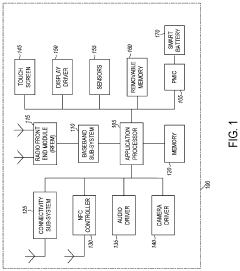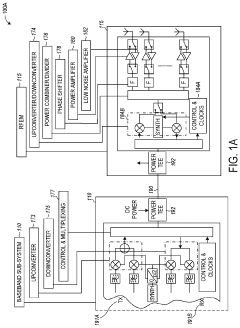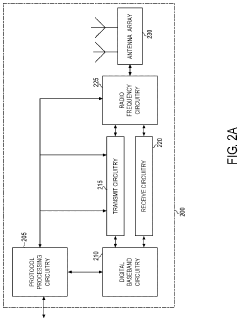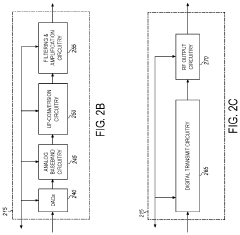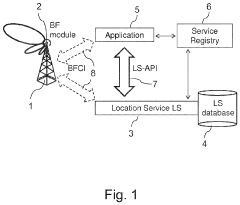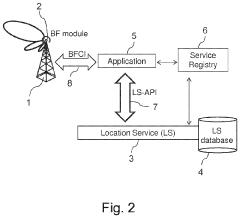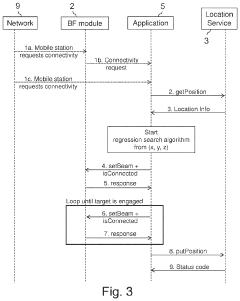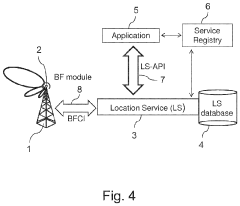Optimizing Autonomous Drone Networks with mmWave Connectivity
SEP 22, 202510 MIN READ
Generate Your Research Report Instantly with AI Agent
Patsnap Eureka helps you evaluate technical feasibility & market potential.
mmWave Drone Connectivity Background and Objectives
Millimeter wave (mmWave) technology has emerged as a promising solution for high-bandwidth wireless communications, operating in frequency bands between 30 GHz and 300 GHz. The evolution of this technology began in the early 2000s with experimental research, followed by standardization efforts in the 2010s that culminated in the inclusion of mmWave bands in 5G specifications. This technological progression has been driven by the increasing demand for higher data rates and lower latency in wireless communications.
The application of mmWave technology to autonomous drone networks represents a significant technological frontier. Drones, or Unmanned Aerial Vehicles (UAVs), have transitioned from military applications to widespread commercial and civilian use cases including package delivery, surveillance, disaster management, and agricultural monitoring. These applications require reliable, high-bandwidth communication links to transmit sensor data, control signals, and in many cases, high-definition video feeds in real-time.
Traditional drone communication systems rely on sub-6 GHz frequencies, which are becoming increasingly congested and cannot support the bandwidth requirements of advanced autonomous operations. The mmWave spectrum offers substantially wider bandwidth channels, potentially enabling multi-gigabit-per-second data rates that can accommodate the demanding communication needs of next-generation drone networks.
The primary technical objective of optimizing autonomous drone networks with mmWave connectivity is to develop robust communication systems that can overcome the inherent challenges of mmWave propagation. These challenges include high path loss, sensitivity to blockage, and beam alignment difficulties, particularly in dynamic environments where drones are constantly moving. The goal is to create adaptive beamforming techniques, efficient network protocols, and resilient system architectures that can maintain reliable connectivity despite these challenges.
Another critical objective is to minimize the size, weight, and power consumption (SWaP) of mmWave communication systems for drone integration. Drones have strict payload limitations, making it essential to develop compact, lightweight, and energy-efficient mmWave transceivers that do not significantly impact flight time or operational capabilities.
Furthermore, the research aims to explore multi-drone coordination strategies that leverage mmWave connectivity for enhanced autonomous operations. This includes investigating mesh network topologies, relay mechanisms, and distributed computing approaches that can improve overall network resilience and performance.
The long-term vision is to establish a technological foundation for ultra-reliable, high-capacity drone communication networks that can support increasingly sophisticated autonomous behaviors, from coordinated swarm operations to AI-driven decision-making at the edge. This advancement would significantly expand the potential applications and capabilities of autonomous drone systems across various industries.
The application of mmWave technology to autonomous drone networks represents a significant technological frontier. Drones, or Unmanned Aerial Vehicles (UAVs), have transitioned from military applications to widespread commercial and civilian use cases including package delivery, surveillance, disaster management, and agricultural monitoring. These applications require reliable, high-bandwidth communication links to transmit sensor data, control signals, and in many cases, high-definition video feeds in real-time.
Traditional drone communication systems rely on sub-6 GHz frequencies, which are becoming increasingly congested and cannot support the bandwidth requirements of advanced autonomous operations. The mmWave spectrum offers substantially wider bandwidth channels, potentially enabling multi-gigabit-per-second data rates that can accommodate the demanding communication needs of next-generation drone networks.
The primary technical objective of optimizing autonomous drone networks with mmWave connectivity is to develop robust communication systems that can overcome the inherent challenges of mmWave propagation. These challenges include high path loss, sensitivity to blockage, and beam alignment difficulties, particularly in dynamic environments where drones are constantly moving. The goal is to create adaptive beamforming techniques, efficient network protocols, and resilient system architectures that can maintain reliable connectivity despite these challenges.
Another critical objective is to minimize the size, weight, and power consumption (SWaP) of mmWave communication systems for drone integration. Drones have strict payload limitations, making it essential to develop compact, lightweight, and energy-efficient mmWave transceivers that do not significantly impact flight time or operational capabilities.
Furthermore, the research aims to explore multi-drone coordination strategies that leverage mmWave connectivity for enhanced autonomous operations. This includes investigating mesh network topologies, relay mechanisms, and distributed computing approaches that can improve overall network resilience and performance.
The long-term vision is to establish a technological foundation for ultra-reliable, high-capacity drone communication networks that can support increasingly sophisticated autonomous behaviors, from coordinated swarm operations to AI-driven decision-making at the edge. This advancement would significantly expand the potential applications and capabilities of autonomous drone systems across various industries.
Market Analysis for Autonomous Drone Network Solutions
The autonomous drone network solutions market is experiencing unprecedented growth, driven by technological advancements in millimeter wave (mmWave) connectivity and increasing demand across multiple sectors. Current market valuations place the global commercial drone market at approximately 30 billion USD in 2023, with projections indicating a compound annual growth rate of 25% through 2030. Within this broader market, autonomous drone networks represent one of the fastest-growing segments, particularly those leveraging advanced connectivity solutions like mmWave technology.
The primary market drivers for autonomous drone networks with mmWave connectivity include the expanding need for high-bandwidth, low-latency communications in drone swarms, increasing adoption of drones in logistics and delivery services, and growing demand for real-time data transmission in surveillance and monitoring applications. The logistics and transportation sector currently accounts for the largest market share at 32%, followed by agriculture (24%), infrastructure inspection (18%), and security and surveillance (15%).
Regional analysis reveals North America as the dominant market with approximately 40% share, attributed to favorable regulatory frameworks and substantial investments in drone technology. Asia-Pacific represents the fastest-growing region with a projected 30% annual growth rate, driven by rapid industrialization in China and India, alongside significant government initiatives supporting drone technology development.
Key customer segments include enterprise-level corporations seeking efficient logistics solutions, government agencies requiring advanced surveillance capabilities, agricultural enterprises adopting precision farming techniques, and infrastructure companies implementing automated inspection protocols. These segments demonstrate varying price sensitivity, with government and large enterprise customers prioritizing performance over cost considerations.
Market challenges include regulatory hurdles affecting widespread deployment, concerns regarding data security and privacy, and technical limitations in current mmWave implementations for drone networks. Despite these challenges, the market demonstrates strong growth potential, particularly as regulatory frameworks mature and technical solutions evolve.
Competitive analysis indicates a fragmented market landscape with several specialized players focusing on niche applications. The market is witnessing increasing consolidation through strategic partnerships and acquisitions, as companies seek to build comprehensive solution portfolios combining hardware, software, and connectivity expertise.
Future market projections suggest that autonomous drone networks with mmWave connectivity will experience accelerated adoption in smart city initiatives, emergency response systems, and environmental monitoring applications, creating new market opportunities estimated at 12 billion USD by 2028.
The primary market drivers for autonomous drone networks with mmWave connectivity include the expanding need for high-bandwidth, low-latency communications in drone swarms, increasing adoption of drones in logistics and delivery services, and growing demand for real-time data transmission in surveillance and monitoring applications. The logistics and transportation sector currently accounts for the largest market share at 32%, followed by agriculture (24%), infrastructure inspection (18%), and security and surveillance (15%).
Regional analysis reveals North America as the dominant market with approximately 40% share, attributed to favorable regulatory frameworks and substantial investments in drone technology. Asia-Pacific represents the fastest-growing region with a projected 30% annual growth rate, driven by rapid industrialization in China and India, alongside significant government initiatives supporting drone technology development.
Key customer segments include enterprise-level corporations seeking efficient logistics solutions, government agencies requiring advanced surveillance capabilities, agricultural enterprises adopting precision farming techniques, and infrastructure companies implementing automated inspection protocols. These segments demonstrate varying price sensitivity, with government and large enterprise customers prioritizing performance over cost considerations.
Market challenges include regulatory hurdles affecting widespread deployment, concerns regarding data security and privacy, and technical limitations in current mmWave implementations for drone networks. Despite these challenges, the market demonstrates strong growth potential, particularly as regulatory frameworks mature and technical solutions evolve.
Competitive analysis indicates a fragmented market landscape with several specialized players focusing on niche applications. The market is witnessing increasing consolidation through strategic partnerships and acquisitions, as companies seek to build comprehensive solution portfolios combining hardware, software, and connectivity expertise.
Future market projections suggest that autonomous drone networks with mmWave connectivity will experience accelerated adoption in smart city initiatives, emergency response systems, and environmental monitoring applications, creating new market opportunities estimated at 12 billion USD by 2028.
Current mmWave Technology Challenges in Aerial Applications
Millimeter wave (mmWave) technology, operating in the frequency range of 30-300 GHz, offers tremendous potential for high-bandwidth communication in autonomous drone networks. However, its implementation in aerial applications faces significant technical challenges that must be addressed to realize its full potential. These challenges stem from the unique characteristics of mmWave signals and the dynamic nature of aerial environments.
Signal propagation represents a primary concern in aerial mmWave applications. Unlike lower frequency signals, mmWave transmissions are highly susceptible to atmospheric attenuation, particularly from oxygen absorption, rainfall, and humidity. This vulnerability intensifies in aerial contexts where drones operate across varying altitudes with changing atmospheric conditions. The limited propagation range of mmWave signals—typically restricted to a few hundred meters in optimal conditions—further complicates reliable connectivity for wide-area drone operations.
Beam alignment and tracking present another critical challenge. The highly directional nature of mmWave communication necessitates precise alignment between transmitter and receiver antennas. In aerial applications, this requirement becomes exponentially more complex due to the continuous movement of drones, which introduces multi-dimensional mobility patterns. Current beam tracking algorithms struggle to maintain optimal alignment during rapid drone maneuvers, resulting in frequent connection interruptions and reduced throughput.
Power constraints significantly impact mmWave implementation in drone systems. The technology's signal processing requirements demand substantial computational resources and power consumption—resources that are inherently limited in drone platforms due to payload and flight time considerations. This creates a fundamental tension between communication capabilities and operational endurance that current energy solutions have not adequately resolved.
Hardware miniaturization remains problematic for aerial mmWave applications. While terrestrial mmWave systems have seen progressive miniaturization, aerial platforms require even more compact, lightweight solutions that can withstand vibration, temperature variations, and other environmental stresses. Current antenna array designs and RF components often prove too bulky or fragile for effective drone integration, limiting practical deployment options.
Network coordination challenges emerge when scaling from single-drone to multi-drone operations. Establishing and maintaining a mesh network of mmWave-connected drones requires sophisticated handover mechanisms, interference management protocols, and dynamic routing algorithms. Current solutions struggle with the three-dimensional mobility patterns of drone swarms, leading to network instability and reduced overall performance.
Regulatory uncertainties further complicate mmWave adoption in aerial applications. The spectrum allocation for mmWave varies significantly across regions, creating compliance challenges for drone operations that may cross jurisdictional boundaries. Additionally, safety concerns regarding high-frequency emissions from aerial platforms have prompted cautious regulatory approaches that may limit deployment scenarios.
Signal propagation represents a primary concern in aerial mmWave applications. Unlike lower frequency signals, mmWave transmissions are highly susceptible to atmospheric attenuation, particularly from oxygen absorption, rainfall, and humidity. This vulnerability intensifies in aerial contexts where drones operate across varying altitudes with changing atmospheric conditions. The limited propagation range of mmWave signals—typically restricted to a few hundred meters in optimal conditions—further complicates reliable connectivity for wide-area drone operations.
Beam alignment and tracking present another critical challenge. The highly directional nature of mmWave communication necessitates precise alignment between transmitter and receiver antennas. In aerial applications, this requirement becomes exponentially more complex due to the continuous movement of drones, which introduces multi-dimensional mobility patterns. Current beam tracking algorithms struggle to maintain optimal alignment during rapid drone maneuvers, resulting in frequent connection interruptions and reduced throughput.
Power constraints significantly impact mmWave implementation in drone systems. The technology's signal processing requirements demand substantial computational resources and power consumption—resources that are inherently limited in drone platforms due to payload and flight time considerations. This creates a fundamental tension between communication capabilities and operational endurance that current energy solutions have not adequately resolved.
Hardware miniaturization remains problematic for aerial mmWave applications. While terrestrial mmWave systems have seen progressive miniaturization, aerial platforms require even more compact, lightweight solutions that can withstand vibration, temperature variations, and other environmental stresses. Current antenna array designs and RF components often prove too bulky or fragile for effective drone integration, limiting practical deployment options.
Network coordination challenges emerge when scaling from single-drone to multi-drone operations. Establishing and maintaining a mesh network of mmWave-connected drones requires sophisticated handover mechanisms, interference management protocols, and dynamic routing algorithms. Current solutions struggle with the three-dimensional mobility patterns of drone swarms, leading to network instability and reduced overall performance.
Regulatory uncertainties further complicate mmWave adoption in aerial applications. The spectrum allocation for mmWave varies significantly across regions, creating compliance challenges for drone operations that may cross jurisdictional boundaries. Additionally, safety concerns regarding high-frequency emissions from aerial platforms have prompted cautious regulatory approaches that may limit deployment scenarios.
Existing mmWave Implementation Strategies for Drone Networks
01 Millimeter Wave (mmWave) Communication Optimization for Drone Networks
Millimeter wave communication technologies are implemented in autonomous drone networks to achieve high-bandwidth, low-latency connectivity. These systems utilize beamforming techniques and adaptive algorithms to optimize signal strength and overcome the inherent challenges of mmWave propagation, such as atmospheric absorption and limited range. Advanced antenna arrays enable directional transmission, improving connectivity between drones and ground stations while minimizing interference in dense network environments.- mmWave Beamforming for Drone Communication: Millimeter wave (mmWave) beamforming techniques are implemented in autonomous drone networks to optimize connectivity. These techniques involve directional antenna arrays that can dynamically adjust beam patterns to maintain high-bandwidth connections between drones and ground stations. Advanced algorithms enable real-time beam tracking and alignment to compensate for drone mobility, ensuring stable communication links even during flight maneuvers. This technology significantly enhances data throughput and connection reliability in drone networks.
- Autonomous Positioning for Optimal mmWave Coverage: Drones in autonomous networks can dynamically position themselves to optimize mmWave connectivity. Using AI-based algorithms, drones analyze signal quality metrics and environmental conditions to determine optimal hovering positions that maximize coverage and minimize interference. This self-organizing capability allows the network to adapt to changing conditions, maintain connectivity in challenging environments, and create temporary communication infrastructure in areas with limited or damaged terrestrial networks.
- Multi-Drone Relay Systems for Extended Coverage: Multi-drone relay systems employ multiple autonomous drones to extend mmWave connectivity over large areas. These systems create mesh networks where drones serve as aerial nodes, relaying high-bandwidth signals between distant points. The drones coordinate their movements and beam directions to maintain optimal signal paths, enabling connectivity in challenging terrains or disaster-affected regions where traditional infrastructure is unavailable. Advanced routing protocols ensure efficient data transmission across the network while minimizing latency.
- Energy-Efficient mmWave Communication Protocols: Energy-efficient communication protocols are developed specifically for mmWave-equipped drone networks to extend operational flight time. These protocols implement adaptive power control mechanisms that adjust transmission power based on distance, channel conditions, and data requirements. Sleep-wake scheduling algorithms allow drones to conserve energy when full connectivity is not required. Additionally, machine learning techniques optimize the trade-off between communication performance and energy consumption, ensuring drones can maintain essential connectivity while maximizing mission duration.
- Interference Mitigation in Dense Drone Networks: Interference mitigation techniques are crucial for dense autonomous drone networks using mmWave connectivity. These include spatial filtering methods that leverage the directional nature of mmWave transmissions to reduce interference between nearby drones. Dynamic frequency allocation algorithms assign optimal channels to different drone pairs based on their spatial distribution. Additionally, coordinated transmission scheduling prevents simultaneous transmissions that could cause interference. These techniques collectively enable higher drone density without communication degradation, supporting applications requiring multiple drones in close proximity.
02 Autonomous Positioning and Formation Control for Drone Swarms
Drone networks employ sophisticated positioning algorithms that enable autonomous formation control and spatial distribution optimization. These systems dynamically adjust drone positions to maintain optimal mmWave connectivity while fulfilling mission objectives. Machine learning techniques are used to predict optimal formations based on environmental conditions, network traffic demands, and coverage requirements. The positioning systems account for physical constraints, obstacle avoidance, and energy efficiency while maintaining reliable communication links between network nodes.Expand Specific Solutions03 Network Topology Management and Routing Protocols
Specialized routing protocols and network topology management systems are implemented to optimize connectivity in autonomous drone networks. These systems dynamically reconfigure network topology based on changing conditions, traffic demands, and mission requirements. Mesh networking capabilities allow drones to relay communications between nodes that lack direct line-of-sight, enhancing overall network resilience. The protocols incorporate predictive analytics to anticipate connectivity issues and proactively adjust routing paths to maintain optimal data throughput across the network.Expand Specific Solutions04 Energy-Efficient Communication and Resource Allocation
Energy optimization techniques are employed to extend operational duration of drone networks while maintaining mmWave connectivity. These systems implement adaptive power control mechanisms that adjust transmission power based on distance, environmental conditions, and required data rates. Resource allocation algorithms distribute communication resources efficiently across the network, balancing between connectivity requirements and energy constraints. Sleep-wake scheduling and duty cycling further reduce energy consumption during periods of low network activity.Expand Specific Solutions05 Interference Management and Spectrum Utilization
Advanced interference management techniques are implemented to optimize spectrum utilization in dense drone networks using mmWave frequencies. These systems employ spatial multiplexing, frequency division, and time division techniques to maximize concurrent transmissions. Cognitive radio capabilities allow drones to dynamically select optimal frequency channels based on real-time spectrum sensing. Interference cancellation algorithms and coordinated multipoint transmission further enhance spectral efficiency and network capacity while maintaining reliable connectivity between autonomous drones.Expand Specific Solutions
Leading Companies in Drone Connectivity Ecosystem
The autonomous drone network market utilizing mmWave connectivity is in its early growth phase, with significant expansion potential driven by increasing demand for high-bandwidth, low-latency communications in unmanned aerial systems. The market is projected to grow substantially as industries adopt drone swarms for various applications. Technologically, companies like Qualcomm, Intel, and Huawei lead hardware development, while academic institutions such as MIT and Nanjing University of Aeronautics & Astronautics contribute foundational research. Telecom giants including Ericsson, Nokia, and Samsung are integrating mmWave drone connectivity into their 5G/6G roadmaps. The technology remains in active development with standardization efforts ongoing, suggesting commercial maturity is 2-3 years away for widespread implementation.
Intel Corp.
Technical Solution: Intel's solution for autonomous drone networks leverages their RealSense technology combined with mmWave connectivity modules based on their 5G infrastructure. Their approach focuses on edge computing integration, where drones are equipped with Intel Movidius VPUs (Vision Processing Units) that process sensor data locally while maintaining high-bandwidth, low-latency communication through mmWave links. Intel has developed specialized mmWave antenna arrays that are optimized for size, weight, and power constraints of aerial vehicles, achieving a 40% reduction in form factor compared to standard implementations. Their system employs a mesh networking architecture where drones can communicate directly with each other using mmWave links, reducing dependency on ground infrastructure and extending operational range. Intel's solution incorporates AI-driven network optimization that continuously adjusts transmission parameters based on environmental conditions, flight patterns, and mission requirements. The platform also features hardware-accelerated security protocols specifically designed to protect the high-bandwidth data streams typical in drone operations, including real-time video and sensor data transmission.
Strengths: Excellent integration with edge computing capabilities; efficient power management optimized for drone operations; strong security features for data protection. Weaknesses: Less specialized in mmWave technology compared to telecommunications-focused competitors; higher computational overhead for network management; more complex implementation requiring specialized hardware components.
Telefonaktiebolaget LM Ericsson
Technical Solution: Ericsson's approach to optimizing autonomous drone networks with mmWave connectivity leverages their extensive 5G infrastructure expertise. Their solution centers on their Street Macro 6701 mmWave base stations adapted for aerial coverage patterns through specialized antenna configurations. Ericsson has developed a unique network architecture that combines wide-area sub-6GHz coverage for control signals with high-capacity mmWave connectivity for payload data, creating a dual-layer communication system that enhances reliability while maximizing throughput. Their platform implements advanced network slicing techniques that create isolated virtual networks for different drone operations, ensuring critical communications remain unaffected by high-bandwidth applications. Ericsson's solution features their proprietary Spectrum Sharing technology that dynamically allocates frequency resources between ground and aerial users, optimizing overall spectrum efficiency. The system incorporates edge computing capabilities that enable distributed processing of sensor data, reducing backhaul requirements and improving response times for autonomous operations. Ericsson has also developed specialized handover protocols that maintain session continuity across different radio access technologies, essential for maintaining control during transitions between coverage areas.
Strengths: Comprehensive end-to-end network solution; excellent integration with existing cellular infrastructure; superior network management capabilities for mixed ground/aerial operations. Weaknesses: Less focus on drone-specific hardware; requires significant ground infrastructure investment; more complex implementation compared to specialized drone communication systems.
Critical Patents and Research in Drone mmWave Communications
Millimeter wave (MMWAVE) system and methods
PatentActiveUS11811439B2
Innovation
- The implementation of a mmWave receiver system with a radio frequency front end, delta-sigma analog-to-digital converters, gain controllers, and interference estimator circuitry that operates in two modes: one for unfiltered operation when no interference is detected and another for interference cancellation when interference is present, adjusting gain to minimize distortion and ensure signal reliability.
Service location method and system for mmwave cellular environments
PatentActiveUS20210227488A1
Innovation
- A method and system that decouples the beamforming module from the application layer, utilizing a location service to provide and update user terminal location information, enabling improved beam steering and association procedures through a location service entity connected to mmWave access points, facilitating faster terminal discovery and communication.
Regulatory Framework for Aerial Communication Systems
The regulatory landscape governing aerial communication systems presents a complex framework that directly impacts the deployment of mmWave-enabled autonomous drone networks. Current regulations across major jurisdictions primarily focus on three critical aspects: flight operations, spectrum allocation, and data privacy. The Federal Aviation Administration (FAA) in the United States, the European Union Aviation Safety Agency (EASA), and similar bodies in Asia have established altitude restrictions, no-fly zones, and registration requirements that constrain drone network topologies and operational parameters.
Spectrum allocation regulations pose particular challenges for mmWave implementation in drone networks. The International Telecommunication Union (ITU) has designated specific frequency bands for aerial communications, but the high-frequency mmWave bands (typically 30-300 GHz) face varying regulatory approaches across regions. The United States Federal Communications Commission (FCC) has opened portions of the 24 GHz, 28 GHz, and 39 GHz bands for potential aerial applications, while the European Conference of Postal and Telecommunications Administrations (CEPT) has adopted a more conservative approach with stricter power limitations.
Regulatory compliance for autonomous drone networks requires addressing technical certification standards that vary significantly between jurisdictions. These include electromagnetic compatibility (EMC) requirements, radiation safety standards, and interference mitigation protocols. The IEEE 802.11ay standard, which supports mmWave communications, must be implemented within these regulatory constraints, often requiring adaptive power control mechanisms and dynamic frequency selection capabilities.
Data privacy and security regulations further complicate the deployment landscape. The General Data Protection Regulation (GDPR) in Europe and similar frameworks in other regions impose strict requirements on data collection, processing, and transmission by aerial systems. These regulations necessitate end-to-end encryption, secure authentication protocols, and transparent data handling practices for mmWave-enabled drone communications.
Emerging regulatory trends indicate a move toward performance-based regulations rather than prescriptive rules, potentially offering greater flexibility for innovative mmWave drone network architectures. Regulatory sandboxes in countries like Singapore, the UK, and Japan are providing controlled environments for testing advanced aerial communication systems with reduced regulatory barriers. These initiatives may accelerate the development of optimized mmWave connectivity solutions while ensuring appropriate safety and security safeguards.
Cross-border operations present additional regulatory challenges, as harmonization efforts between national regulatory frameworks remain incomplete. This fragmentation creates significant compliance burdens for global deployment of mmWave-enabled autonomous drone networks, necessitating adaptable system designs that can conform to diverse regulatory requirements.
Spectrum allocation regulations pose particular challenges for mmWave implementation in drone networks. The International Telecommunication Union (ITU) has designated specific frequency bands for aerial communications, but the high-frequency mmWave bands (typically 30-300 GHz) face varying regulatory approaches across regions. The United States Federal Communications Commission (FCC) has opened portions of the 24 GHz, 28 GHz, and 39 GHz bands for potential aerial applications, while the European Conference of Postal and Telecommunications Administrations (CEPT) has adopted a more conservative approach with stricter power limitations.
Regulatory compliance for autonomous drone networks requires addressing technical certification standards that vary significantly between jurisdictions. These include electromagnetic compatibility (EMC) requirements, radiation safety standards, and interference mitigation protocols. The IEEE 802.11ay standard, which supports mmWave communications, must be implemented within these regulatory constraints, often requiring adaptive power control mechanisms and dynamic frequency selection capabilities.
Data privacy and security regulations further complicate the deployment landscape. The General Data Protection Regulation (GDPR) in Europe and similar frameworks in other regions impose strict requirements on data collection, processing, and transmission by aerial systems. These regulations necessitate end-to-end encryption, secure authentication protocols, and transparent data handling practices for mmWave-enabled drone communications.
Emerging regulatory trends indicate a move toward performance-based regulations rather than prescriptive rules, potentially offering greater flexibility for innovative mmWave drone network architectures. Regulatory sandboxes in countries like Singapore, the UK, and Japan are providing controlled environments for testing advanced aerial communication systems with reduced regulatory barriers. These initiatives may accelerate the development of optimized mmWave connectivity solutions while ensuring appropriate safety and security safeguards.
Cross-border operations present additional regulatory challenges, as harmonization efforts between national regulatory frameworks remain incomplete. This fragmentation creates significant compliance burdens for global deployment of mmWave-enabled autonomous drone networks, necessitating adaptable system designs that can conform to diverse regulatory requirements.
Energy Efficiency Considerations for mmWave-Enabled Drones
Energy efficiency represents a critical challenge in the deployment of mmWave-enabled drone networks. The high-frequency operation of millimeter wave (mmWave) communication systems inherently demands significant power consumption, primarily due to the need for multiple antenna arrays and sophisticated signal processing capabilities. When integrated into autonomous drone platforms, these power requirements create substantial constraints on flight time and operational range.
Current mmWave radio frequency (RF) front-end designs typically consume between 2-5 watts per transceiver chain, which becomes particularly problematic when implementing massive MIMO configurations necessary for effective beamforming. This power demand directly competes with the drone's propulsion system, which generally accounts for 70-80% of the total energy budget in conventional drone operations.
Battery technology limitations further exacerbate these challenges. Despite advancements in lithium-polymer and lithium-ion technologies, energy density improvements have only increased by approximately 5-8% annually, insufficient to match the growing power demands of sophisticated communication systems. The weight-to-capacity ratio remains a significant bottleneck, with current high-capacity batteries adding substantial mass to drone platforms.
Several promising approaches are emerging to address these energy efficiency concerns. Adaptive beamforming algorithms that dynamically adjust the number of active antenna elements based on channel conditions can reduce power consumption by 30-40% during non-peak transmission periods. Similarly, context-aware transmission scheduling that prioritizes critical communications while deferring non-essential data transfers has demonstrated energy savings of up to 25% in field tests.
Hardware innovations are equally important, with recent developments in gallium nitride (GaN) and silicon germanium (SiGe) RF components showing 15-20% improvements in power efficiency compared to conventional silicon-based alternatives. Energy harvesting technologies, particularly solar panels optimized for drone form factors, can supplement battery power by 10-15% under favorable conditions, extending operational durations.
Network-level optimizations also offer significant potential. Cooperative relay strategies among drone swarms can reduce individual transmission power requirements by distributing communication loads across multiple nodes. Machine learning algorithms that predict optimal flight paths considering both communication quality and energy consumption have demonstrated 18-22% improvements in overall energy efficiency in simulated urban environments.
As mmWave drone networks transition from experimental to practical deployment stages, these energy efficiency considerations will increasingly determine their commercial viability and operational effectiveness across various use cases, from emergency response to infrastructure inspection.
Current mmWave radio frequency (RF) front-end designs typically consume between 2-5 watts per transceiver chain, which becomes particularly problematic when implementing massive MIMO configurations necessary for effective beamforming. This power demand directly competes with the drone's propulsion system, which generally accounts for 70-80% of the total energy budget in conventional drone operations.
Battery technology limitations further exacerbate these challenges. Despite advancements in lithium-polymer and lithium-ion technologies, energy density improvements have only increased by approximately 5-8% annually, insufficient to match the growing power demands of sophisticated communication systems. The weight-to-capacity ratio remains a significant bottleneck, with current high-capacity batteries adding substantial mass to drone platforms.
Several promising approaches are emerging to address these energy efficiency concerns. Adaptive beamforming algorithms that dynamically adjust the number of active antenna elements based on channel conditions can reduce power consumption by 30-40% during non-peak transmission periods. Similarly, context-aware transmission scheduling that prioritizes critical communications while deferring non-essential data transfers has demonstrated energy savings of up to 25% in field tests.
Hardware innovations are equally important, with recent developments in gallium nitride (GaN) and silicon germanium (SiGe) RF components showing 15-20% improvements in power efficiency compared to conventional silicon-based alternatives. Energy harvesting technologies, particularly solar panels optimized for drone form factors, can supplement battery power by 10-15% under favorable conditions, extending operational durations.
Network-level optimizations also offer significant potential. Cooperative relay strategies among drone swarms can reduce individual transmission power requirements by distributing communication loads across multiple nodes. Machine learning algorithms that predict optimal flight paths considering both communication quality and energy consumption have demonstrated 18-22% improvements in overall energy efficiency in simulated urban environments.
As mmWave drone networks transition from experimental to practical deployment stages, these energy efficiency considerations will increasingly determine their commercial viability and operational effectiveness across various use cases, from emergency response to infrastructure inspection.
Unlock deeper insights with Patsnap Eureka Quick Research — get a full tech report to explore trends and direct your research. Try now!
Generate Your Research Report Instantly with AI Agent
Supercharge your innovation with Patsnap Eureka AI Agent Platform!
